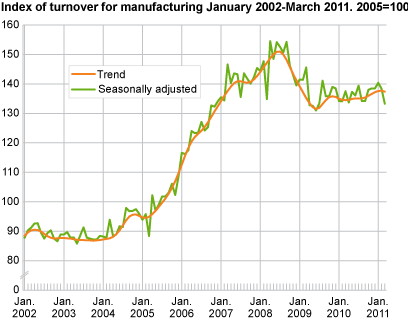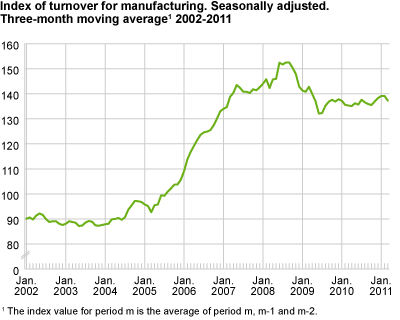Content
Published:
This is an archived release.
Stable industrial turnover
The total turnover in Norwegian manufacturing had a small drop of 0.7 per cent from the fourth quarter of 2010 to the first quarter of 2011, according to seasonally-adjusted figures.
Turnover within the industry related to building of ships, boats and oil platforms fell by 27 per cent from the fourth quarter of 2010 to the first quarter of 2011, according to seasonally-adjusted figures. Some of this decrease was due to the reclassification of several enterprises from manufacturing to service activities (see the first explanatory box below). Machinery and equipment and repair, installation of machinery reduced the turnover by 5.7 and 5.4 per cent respectively.
Among the industries with positive results in the same period were basic metals, up 9.2 per cent, while computer and electrical equipment went up by 7.1 per cent. The growth within both of these industries can partially be explained by an increased production volume, see the Index of production . Higher metal prices in the 1st quarter of 2011 has also contributed positively to the basic metals industry in this period.
Turnover from February to March 2011
Seasonally-adjusted figures showed that the turnover in Norwegian manufacturing went down by 3.6 per cent from February to March this year. Building of ships, boats and oil platforms fell by 9.6 per cent. Fabricated metal products drop by 6.7 per cent. Basic metals showed a tiny fall by 0.8 per cent. Slightly lower metal prices in February contributed to this, see the Producer price index .
Decreased turnover from March 2010
Unadjusted figures showed that the total manufacturing turnover fell 2.7 per cent since the same month last year. This was due to a decrease in turnover in the home market, while the export market showed growth. The industries that had the greatest impact were building of ships, boats and oil platforms, with a fall of 34 per cent. Machinery and equipment drop by 9.6 per cent, while repair and installation of machinery fell by 11.3 per cent. Turnover within food products fell 3.2 per cent from March last year.
On the other hand, industries with increased turnover included rubber, plastic and mineral products, up 15.6 per cent, while basic metals went up 21.8 per cent in the same period. Turnover within refined petroleum, chemicals and pharmaceuticals increased by 4.3 per cent compared to March 2010.
Norway and the euro area
Unadjusted figures show that Norwegian manufacturing turnover went up by 3.3 per cent from February 2010 to February 2011. Manufacturing turnover in the euro area went up 16 per cent in the same period, according to figures published by Eurostat . These figures must be considered in relation to the fact that the decline in Norwegian industry was not as pronounced as in the countries in the EU, and had a different course due to differences in the structure of industry.
| Original series.1
January-March 2011 |
Changes in per cent. January-March 2010- January-March 2011 |
Original series.1
March 2011 |
Changes in per cent. March 2010- March 2011 |
Changes in per cent. Seasonally adjusted. October 2010-December 2010- January 2011-March 2011 |
|||||||||||||||||||||||||||||||||||||||||||||||||||||||||||||||||||||||||||
|---|---|---|---|---|---|---|---|---|---|---|---|---|---|---|---|---|---|---|---|---|---|---|---|---|---|---|---|---|---|---|---|---|---|---|---|---|---|---|---|---|---|---|---|---|---|---|---|---|---|---|---|---|---|---|---|---|---|---|---|---|---|---|---|---|---|---|---|---|---|---|---|---|---|---|---|---|---|---|---|
| The overall turnover | 402 106 | 7.0 | 142 800 | 5.3 | 0.4 | ||||||||||||||||||||||||||||||||||||||||||||||||||||||||||||||||||||||||||
| Extraction and related services | 167 320 | 17.3 | 59 199 | 18.9 | 3.5 | ||||||||||||||||||||||||||||||||||||||||||||||||||||||||||||||||||||||||||
| Manufacturing, mining and quarrying | 185 549 | 0.9 | 67 397 | -2.5 | -0.5 | ||||||||||||||||||||||||||||||||||||||||||||||||||||||||||||||||||||||||||
| Domestic market | 109 799 | -1.0 | 39 364 | -7.0 | -4.7 | ||||||||||||||||||||||||||||||||||||||||||||||||||||||||||||||||||||||||||
| Export market | 75 750 | 3.9 | 28 033 | 4.6 | 6.1 | ||||||||||||||||||||||||||||||||||||||||||||||||||||||||||||||||||||||||||
| Electricity, Gas and Steam Supply | 49 237 | -0.2 | 16 204 | -3.2 | -2.1 | ||||||||||||||||||||||||||||||||||||||||||||||||||||||||||||||||||||||||||
| Main industrial groupings | |||||||||||||||||||||||||||||||||||||||||||||||||||||||||||||||||||||||||||||||
| Intermediate goods | 86 390 | 15.9 | 31 499 | 13.6 | 4.2 | ||||||||||||||||||||||||||||||||||||||||||||||||||||||||||||||||||||||||||
| Capital goods | 49 378 | -15.7 | 18 458 | -17.9 | -8.6 | ||||||||||||||||||||||||||||||||||||||||||||||||||||||||||||||||||||||||||
| Consumer goods | 46 755 | -1.9 | 16 781 | -4.5 | -0.8 | ||||||||||||||||||||||||||||||||||||||||||||||||||||||||||||||||||||||||||
| Energy goods | 219 583 | 12.6 | 76 062 | 12.1 | 1.2 | ||||||||||||||||||||||||||||||||||||||||||||||||||||||||||||||||||||||||||
| 1 | NOK million. |
From manufacturing to services in oil and gas extractionAs from January 2011, several enterprises have been reclassified from manufacturing to service activities in oil and gas extraction in the Central register of establishments and enterprises. As a result, these establishments have been moved from manufacturing to extraction and related services in the statistics on turnover. These changes have also been incorporated into the population that is used to inflate the sample to total turnover in the various industries. Read more about the changes in the annual statistics for oil and gas activity . |
Changes in population basisTurnover from auxiliary enterprises and financial holding companies is excluded from the defined population for the monthly statistics on turnover. This is in accordance with forthcoming changes in the publication of annual manufacturing statistics. |
Interpretation of seasonally-adjusted figuresIn order to facilitate the interpretation of the short-term development, statistics on turnover publishes three-month moving averages of the seasonally-adjusted figures. We normally compare the latest non-overlapping three-month periods (for instance October to December compared with January to March). |
The relationship between production and turnoverThe development in the turnover can be related to changes in both volume and prices in the different industries. Production to stocks and sales from stocks can also happen. Reporting during large deliveries of capital goods can contribute to differences in the development in the index of production and the statistics on turnover. |
Tables
Find more figures
Find detailed figures from Turnover in oil and gas, manufacturing, mining and electricity supply
Additional information
The variation in manufacturing turnover can be related to changes in volume and price indices in different industries and also production to stocks and sales from stocks.
Contact
-
Robert Skotvold
E-mail: robert.skotvold@ssb.no
tel.: (+47) 40 90 24 44
-
Anne Karin Linderud Haugen
E-mail: anne.karin.linderud.haugen@ssb.no
tel.: (+47) 91 88 19 76


